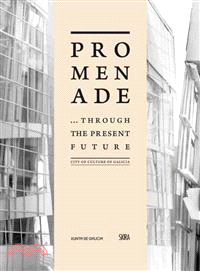| FindBook |
有 1 項符合
Promenade... Through the Present Future: City of Culture of Galicia的圖書 |
 |
Promenade: ...Through the Present Future: City of Culture of Galicia 作者:Anderson,Maxwell L./Chua,Lawrence/Healy,Rachel/Serageldin,Ismail/Villares,Ramon 出版社:Random House Inc 出版日期:2011-10-25 語言:英文 規格:精裝 / 189頁 / 2.5 x 19.7 x 24.8 cm / 普通級/ 譯本 |
| 圖書館借閱 |
| 國家圖書館 | 全國圖書書目資訊網 | 國立公共資訊圖書館 | 電子書服務平台 | MetaCat 跨館整合查詢 |
| 臺北市立圖書館 | 新北市立圖書館 | 基隆市公共圖書館 | 桃園市立圖書館 | 新竹縣公共圖書館 |
| 苗栗縣立圖書館 | 臺中市立圖書館 | 彰化縣公共圖書館 | 南投縣文化局 | 雲林縣公共圖書館 |
| 嘉義縣圖書館 | 臺南市立圖書館 | 高雄市立圖書館 | 屏東縣公共圖書館 | 宜蘭縣公共圖書館 |
| 花蓮縣文化局 | 臺東縣文化處 |
|
|
圖書介紹 - 資料來源:博客來 評分:
圖書名稱:Promenade... Through the Present Future: City of Culture of Galicia
內容簡介
In 1999 the Xunta de Galicia called an International Architecture Competition to build the City of Culture of Galicia on Mount Gaiás in Santiago de Compostela. Twelve proposals by renowned national and international architects' studios were initially submitted to this competition for ideas. The architects who submitted their ideas for defining the architectural complex and its uses were Ricardo Bofill, Peter Eisenman, Manuel Gallego Jorreto, Annette Gigon and Mike Guyer, Steve Holl, Rem Koolhaas, Daniel Libeskind, Juan Navarro Baldeweg, Jean Nouvel, Dominique Perrault, César Portela, and Santiago Calatrava (who later withdrew his project). Out of all these ideas, the final project to be selected for development was the design by Eisenman Architects, as - to quote the Jury - it was, "unique both in concept and plasticity, and exceptionally in tune with the site's location". Located in Santiago de Compostela, a historic city that is an emblem of the European cultural tradition and was declared a World Heritage Site by UNESCO in 1985, the City of Culture of Galicia stands on top of Mount Gaiás, a formidable architectural landmark for the new century. Conceived as a large-scale cultural hub devoted to hosting the best of cultural expressions of Galicia, Spain, Europe, Latin America and the World, this new "city" will contribute with its inclusive and pluralistic approach to meeting the challenges of the information and knowledge society. Its unique buildings, connected up by streets and plazas equipped with state-of-the-art technology, create a space of excellence for reflection, debate and actions oriented towards the preservation of heritage and memory, towards study, research, experimentation, production and dissemination in the field of literature and thinking, music, drama, dance, film, the visual arts, audiovisual creation and communication. This book invites readers to stroll around a new city where past, present, and future cultures coexist: "A new cultural Babylon will open its doors to readers."
|









